
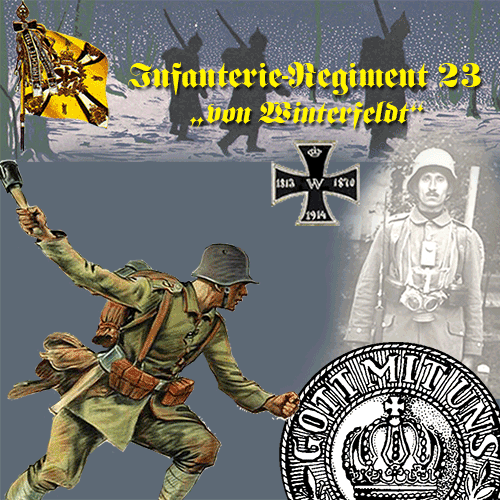
Gas Mask and
Gas Mask Cannister
(Gasmaske und Gasmaskentragebüchse) — Gas masks became standard issue to German troops in August 1915. There are two kinds of repro Gasmasks that reenactors will see (and use) and that’s what we’ll cover here: The Gasschutzmaske M.15 (Gummimaske to collectors and reenactors) and the Gasmaske M.17 (Lederschutzmaske to collectors and reenactors; not being reproed at this time).
The Gasschutzmaske M.15
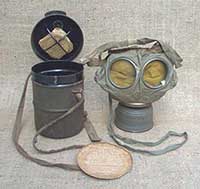
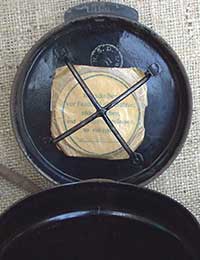 The Gummimaske was made of impermeable rubberized cotton fabric. The stamped round metal frames in eye glasses were made of unbreakable and non-combustible celluloid. The mask was held on the head by two elastic bands. A neck strap allows the gas mask to worn ready for use. Initially, the mask was stored in the breadbag, then later, a gray canvas bag was introduced. In 1916 the storage can carried in the canvas bag was fitted with two straps, sometimes made of „ersatz“ paper-cloth. The original paper-cloth straps were strong and durable but over the years, have become fragile and will no longer hold-up in the trenches! Soldiers were also issued an extra filter with a cloth carrier worn on the belt.
The Gummimaske was made of impermeable rubberized cotton fabric. The stamped round metal frames in eye glasses were made of unbreakable and non-combustible celluloid. The mask was held on the head by two elastic bands. A neck strap allows the gas mask to worn ready for use. Initially, the mask was stored in the breadbag, then later, a gray canvas bag was introduced. In 1916 the storage can carried in the canvas bag was fitted with two straps, sometimes made of „ersatz“ paper-cloth. The original paper-cloth straps were strong and durable but over the years, have become fragile and will no longer hold-up in the trenches! Soldiers were also issued an extra filter with a cloth carrier worn on the belt.
Changes and the Gasmakse M.17
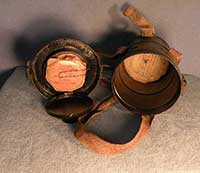
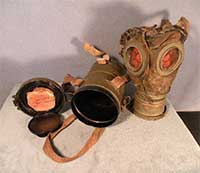 As the war progressed, the effects of the British blockade were felt and Germany ran short of rubber., The rubberized cotton fabric of the Gummimaske began to be replaced by chrome-tanned sheepskin, bought from Bulgaria. The first step was to dip it into sealing oil to render it waterproof. Next, a single piece was cut from the hide and rolled into a cone and cut in three places. Then the seams stitched and lacquered. The seams were cut to allow the lenses to stand clear of the face like goggles. The eye pieces were double-layered (celluloid and cellulose acetate respectively) and coated on the inside with gelatine to prevent misting-up. The coating replaced the wiping folds of the fabric mask and so reduced the dead air space in the mask. The face line was made airtight by fabric-covered, twisted piano wire springs which, it was said, were as good as the earlier elastic tape. Although ingeniously designed, the Gasmaske M.17 (Lederschutzmaske) was inferior to the earlier Gummimaske The leather was smelly and rough, it was also stiffer and a good fit was therefore more difficult to achieve. The Lederschützmaske did not dry quickly and could not be patched with rubber solution, and had to be carefully stowed in its canister to avoid chafing the seams. As if this were not enough, the eyepieces angled differently from the Gummimaske which the solders had become accustomed. One could get used to that but aiming was difficult.
As the war progressed, the effects of the British blockade were felt and Germany ran short of rubber., The rubberized cotton fabric of the Gummimaske began to be replaced by chrome-tanned sheepskin, bought from Bulgaria. The first step was to dip it into sealing oil to render it waterproof. Next, a single piece was cut from the hide and rolled into a cone and cut in three places. Then the seams stitched and lacquered. The seams were cut to allow the lenses to stand clear of the face like goggles. The eye pieces were double-layered (celluloid and cellulose acetate respectively) and coated on the inside with gelatine to prevent misting-up. The coating replaced the wiping folds of the fabric mask and so reduced the dead air space in the mask. The face line was made airtight by fabric-covered, twisted piano wire springs which, it was said, were as good as the earlier elastic tape. Although ingeniously designed, the Gasmaske M.17 (Lederschutzmaske) was inferior to the earlier Gummimaske The leather was smelly and rough, it was also stiffer and a good fit was therefore more difficult to achieve. The Lederschützmaske did not dry quickly and could not be patched with rubber solution, and had to be carefully stowed in its canister to avoid chafing the seams. As if this were not enough, the eyepieces angled differently from the Gummimaske which the solders had become accustomed. One could get used to that but aiming was difficult.
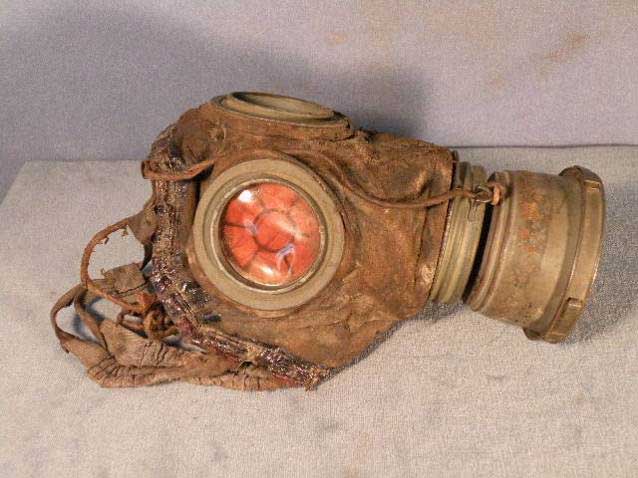
The Tragebüchse is a short, circular canister with a wire clip latch. It has a two part carrying strap, sometimes made of „ersatz“ paper-cloth. It is important to remove original paper-cloth strap from the Tragbüchse—although strong and durable when new, original paper-cloth becomes fragile over time and they will no longer hold-up in the trenches! Soldiers were also issued an extra filter with a cloth belt carrier worn on the belt.
Each member shall carry a proper WWI German Gasmaske (either original or good repro) with the appropriate canister. The spare filter carrier is optional.
- I
 mportant: It is a very good idea to remove and disassemble the original filter on your mask and clean out the interior, as they occasionally still have traces of poison gases such as phosgene in them. If you happen to breath in this gas residue, it can still damage your lungs even after all these years! Also, asbestos was used as one of the filter components and should therefore be removed.
mportant: It is a very good idea to remove and disassemble the original filter on your mask and clean out the interior, as they occasionally still have traces of poison gases such as phosgene in them. If you happen to breath in this gas residue, it can still damage your lungs even after all these years! Also, asbestos was used as one of the filter components and should therefore be removed.

